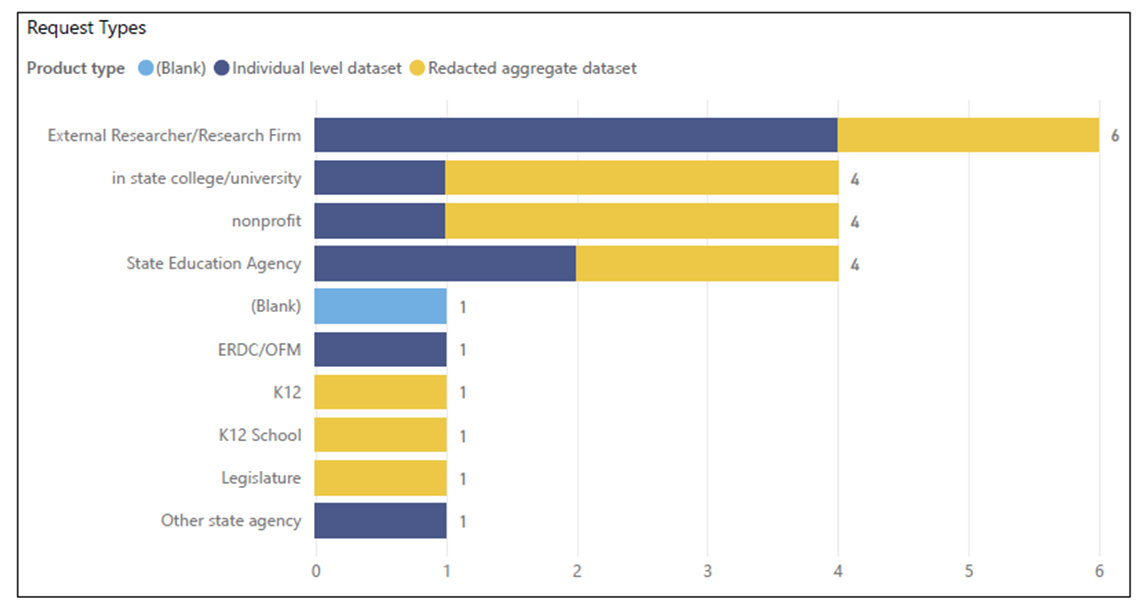|
We’ve heard your feedback and as part of ERDC’s ongoing efforts to improve access to our services and available data, we are teaming up with UXReactor to gather feedback on our website: https://erdc.wa.gov. Your input will be invaluable as we work to enhance the user experience and design to make it easier to access our services and data.
UXReactor will be conducting 45-minute, remote study sessions from mid-late June. If you’re interested in participating, please fill out this form (https://www.surveymonkey.com/r/LYR6FGS) and you will be contacted if you qualify. Upon study completion, you can choose to receive a $100 Amazon gift card as a token of appreciation. Please be mindful of any restrictions for government employees on accepting gifts when choosing to accept the gift card.
Thank you for helping us make the ERDC better!
In March, ERDC executed a new contract with the National Student Clearinghouse (NSC). For a fee, NSC provides ERDC private and out-of-state postsecondary enrollment and completions data which ERDC uses research and reporting, including the High School Outcomes Dashboard. The new contract with NSC will allow ERDC to share school-level reports (see example) and student-level NSC data back to the Office of Superintendent of Public Instruction (OSPI) and school districts. ERDC will be working with OSPI to have the school-level reports available in early 2025 and the student-level data available the following year.
Dual credit and credential attainment
A new research brief in our "Dual Credit Portfolio” provides a first look at the attainment of postsecondary credentials by different types of dual credit participation and found that we barely scratched the surface of interesting analysis that could be done. The brief provides broad answers to questions about credentials and dual credit participation we hope that it piques folks’ interest in digging deeper into the various pathways students take. Some of the key findings include:
- A growing proportion of high school graduates earned an associate award within three years of high school graduation, driven partially by those awarded during high school through Running Start (RS).
- Graduates who enrolled in Advanced Placement (AP), International Baccalaureate (IB), College in the High School (CiHS), and RS had higher rates of earning at least one postsecondary credential within six years of highs school graduation than the statewide average. The magnitude of this rate increase varied by student group and dual credit type.
- Students enrolled in RS earned associate and bachelor’s degrees sooner and with fewer average credits after high school than the statewide average and other dual credit types. RS students were also more likely to have an associate degree as their highest credential than other dual credit types.
Post-high school outcomes
The update to our High School Outcomes Dashboard and an accompanying Data Digest shows that direct enrollment rates are still far below pre-pandemic levels (58% of the class of 2019 compared to 52% for the class of 2022) and that rates have started (or continued) to rebound for some student's groups in the high school class of 2022. Check out the data digest for more key findings and the dashboard for school and district level results!
K12 educators
A new research study examined the characteristics of Washington high school graduates who become teachers and found that of the younger teachers, 68-70% were graduates of Washington public high schools and that these teachers have high employment rates in their “home” school districts. This study helps Washington state better understand the educator pipeline to ensure there are enough educators to meet the demand.
Finance of higher education
ERDC’s first publication of the Public Four-Year Finance Dashboard as required under ESSB 5512, includes financial, liquidity and endowment metrics as well as student-staff ratios. The dashboard allows comparisons across the Washington Public Four-Year Institutions on a variety of metrics that help us understand the financial health and viability of our public institutions.
In the first quarter of 2024 (January – March), ERDC received and authorized 24 data requests for P20W data and delivered 17 requests. This included 10 requests for Individual level datasets and 7 for redacted aggregate requests.
The hard work of the ERDC staff and the continued engagement of our data contributing partners have been pivotal to these successes and will continue to be critical as we move into 2024.

| Requestor type |
Individual level datasets |
Redacted aggregate datasets |
| In-state college/university |
1 |
4 |
| External researcher/research firm |
3 |
0 |
| Nonprofit |
1 |
2 |
| OFM/ERDC |
1 |
1 |
| Other state agency |
1 |
0 |
| State education agency |
1 |
0 |
The hard work of the ERDC staff and the continued engagement of our data contributing partners have been pivotal to these successes and will continue to be critical as we move into 2024.
In April, Bonnie Nelson and Megan Schoor presented their Strategic Data Partnership (SDP) Fellowship capstone projects at the 2024 SDP convening in Boston.
In May, ERDC presented on dual credit and using disaggregated race and ethnicity data at the annual Statewide Longitudinal Data System (SLDS) Best Practices Conference
On June 5 at 12:00 pm Washington Education Research Association (WERA) hosted a Webinar to provide an overview of the High School Outcomes Dashboard and to answer questions and take suggestions for future enhancements.
Do you want to see your group on this list? Invite us to a future meeting by reaching out at erdc@ofm.wa.gov.
The National Science Foundation has awarded Education Northwest and its partners a $3 million grant to produce new and actionable information about how publicly funded housing, health, and human services can better support low-income students’ access and success in science, technology, engineering, and math postsecondary pathways. This project will use ERDC and Department of Social and Health Services (DSHS) data to address key questions related to this topic.
|